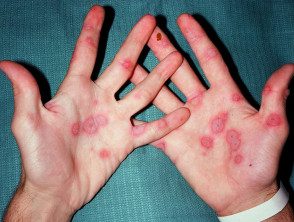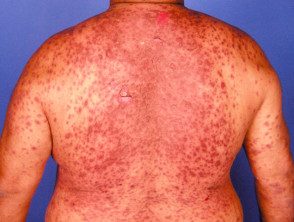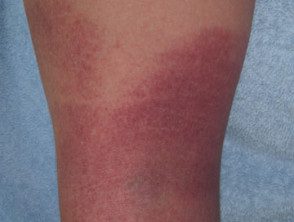Introduction
Many drugs can cause cutaneous (skin) side effects. The severity of symptoms can range from mild eruption to life-threatening conditions that cause skin failure and death. Certain groups of drugs are known to cause frequent, specific or severe skin reactions. Anticonvulsants or antiepileptics are one such group of drugs, some of which have notable side effects on the skin.
It is important to recognize side effects involving the skin, as prompt withdrawal of the medication may prevent worsening of symptoms caused by the medication. A decision may need to be made in a patient who has undergone a drug eruption whether to continue an important drug that might have caused the reaction or switch to an alternative drug.
When faced with a new skin rash in a patient, a full drug history is paramount and should include prescription, on the counterand alternative medications that the patient is taking so that the medication rashes can be considered or discarded.
anti-seizure drugs
Anti-seizure medications, also known as anti-epileptic or anti-seizure medications, are a diverse group of medications that are commonly used in the treatment of epilepsy and seizures, and less commonly for other conditions such as trigeminal neuralgia and bipolar disorder. They work by reducing the excessive firing of neurons that happens in a seizure.
Adverse skin reactions
| Reaction | Symptoms |
|---|---|
| Morbid (similar to measles) drug rash |
|
|
Drug induced urticaria (urticaria) |
|
| Erythema multiform |
|
| Stevens-Johnson syndrome / / toxic epidermal necrolysis (TEN) |
|
| Anticonvulsant hypersensitivity syndrome |
|
Cutaneous adverse reaction to anticonvulsants

morbilliform rash

Urticaria

Erythema multiforme

toxic epidermal necrolysis

purpuric rash

gingival hyperplasia
| Drug | skin reaction | Grades |
|---|---|---|
| Carbamazepine |
|
|
| Phenytoin |
|
|
| Fosphenytoin |
|
|
| Phenobarbital |
|
|
| Lamotrigine |
|
|
| Valproic acid |
|
|
Genetic predisposition to Adverse reactions to anticonvulsants
Some racial groups are especially prone to cutaneous adverse reactions with anticonvulsants. test for an individual allele before starting an anticonvulsant may be helpful in identifying patients at risk.
- Han Chinese and other Southeast Asian groups who have a particular HLA-B allele, HLA-B*1502 they are significantly more likely to develop serious reactions such as Stevens-Johnson syndrome and toxic epidermal necrolysis (TEN) with anticonvulsants.
- Japanese, Korean, and white populations in the United States and Europe who carry HLA-A*31:01 They are also prone to developing cutaneous Adverse drug reactions with anticonvulsants
